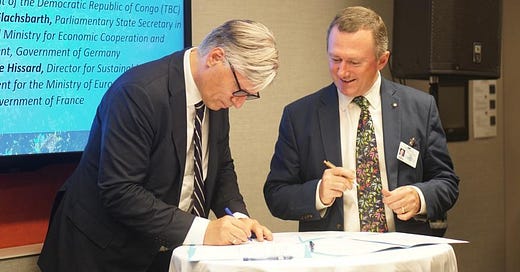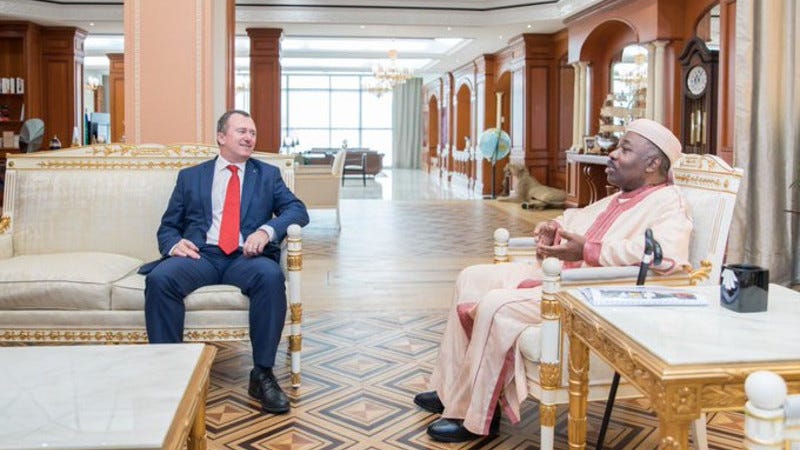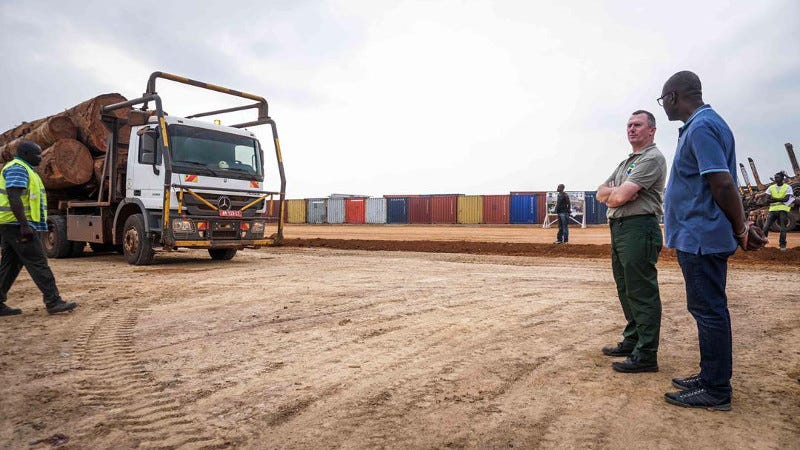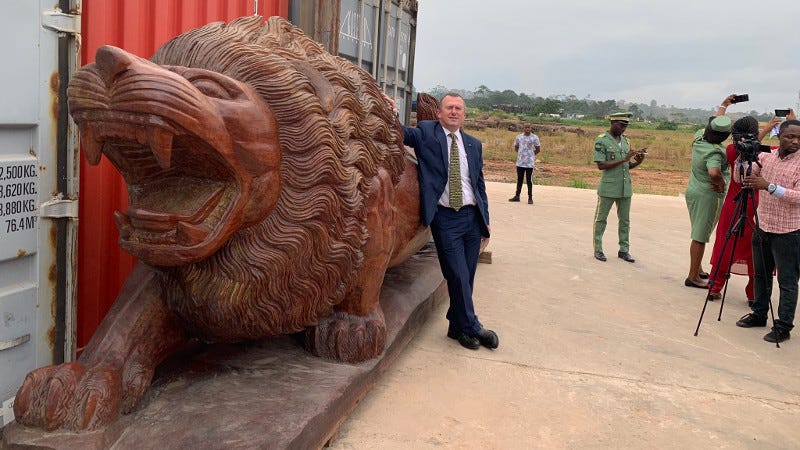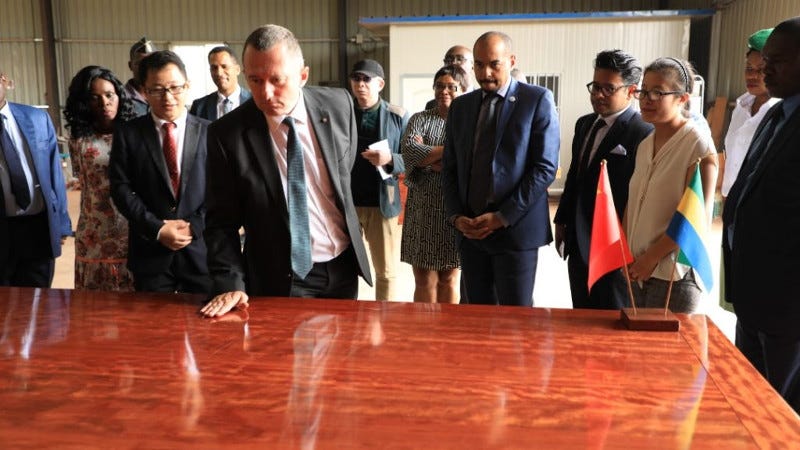Gabon signs US$150 million REDD deal with Norway. Shhh… Don’t mention corruption
At a meeting on 22 September 2019 in New York, Lee White, who was recently appointed Forestry Minister in Gabon, announced a new US$150 million REDD deal with the Central African Forest Initiative. The meeting marked the fifth anniversary of the New York Declaration on Forests. The money will come, surprise, surprise, from Norway.
The session in New York was facilitated by Frances Seymour, Distinguished Senior Fellow at the World Resources Institute. Seymour is also on the Board of Directors of Architecture for REDD+ Transactions (ART). ART recently announced a public consultation on The REDD+ Environmental Excellency Standard (TREES). Comments can be sent until 27 September 2019.
The Addendum to the Letter of Intent between Gabon and CAFI states that,
Gabon will seek to go through ART (Architecture for REDD+ Transactions) certification for the emission reductions and removals under this partnership. This includes the TREES provisions on safeguards reporting and double counting, and ART processes for third party verification.
This whole thing looks a bit like a rushed job. ART doesn’t even have a standard to recognise High Forest Low Deforestation countries, and the TREE Standard is still under public consultation.
Doubling the price of REDD?
In his speech in New York White mentioned that Norway has “agreed to double the price of REDD, from US$5 to US$10”.
That’s a bit of an exaggeration. The Addendum to the Letter of Intent explains that,
CAFI will guarantee a floor price of USD 5 per ton for up to 75 million USD for results achieved in 2016-2020 and up to an additional 75 million USD for results achieved in 2021-25. CAFI will guarantee a floor price of USD 10 per ton for results certified by ART provided that the overall financial commitment from CAFI remains at up to USD 150 million for the 2016-25 period.
But even if Norway does pay twice as much for REDD credits under the 10 year agreement, it will only buy half as many credits. The end result of the 10 year deal will be that the same amount of money is transferred from Norway to Gabon.
Kévazingogate
Lee White became Gabon’s Minister for Forests, Sea, the Environment and Climate Plan in June 2019.
His appointment followed “kévazingogate” – a scandal that involved more than 350 containers of kevazingo wood being discovered at the port of Owendo, ready to be exported. In 2010, Gabon put in place a log export ban.
BBC News reported on the story:
The containers were found in depots belonging to Chinese companies, falsely labelled, allegedly with the forestry ministry label.
Then the containers mysteriously disappeared. About 200 of them have since been recovered.
It is not clear how much the missing wood was worth. Reuters news agency says it had a street value of $250m (£200m).
White: “I have not spoken with Norway about corruption”
After the signing of the deal with CAFI, Le Monde asked White about kévazingogate and how he could guarantee to Norway that Gabon can control corruption. White responded,
Sanctions have been taken and I have not spoken with Norway about corruption, but tons of CO₂ which we pledge to sequester to help stabilise the climate. We have satellite surveillance and, on the ground, intelligence and security services that I will mobilise. The reform of the Penal Code, which came into effect last month, significantly toughens penalties for environmental crimes, including poaching of protected species, such as elephants, or trafficking in natural resources.
Not talking to Norway about corruption may have been something of an oversight.
Gabon is one of the richest countries in Africa. It exports oil, timber and palm oil. It is the world’s third biggest producer of manganese. It is also, as The Economist reports, “one of Africa’s worst-run countries”.
It has had only two presidents since 1967: Omar Bongo, and his son Ali Bongo.
White has lived and worked in Gabon since 1989. In his speech in New York, White says, “I’ve worked with some remarkable heads of state”. The Independent described Omar Bongo as a “corrupt nepotist”. When he died in 2009, he was one of the richest men in the world, with 33 properties in Paris and on the Riviera worth an estimated US$190 million.
By 2009, Gabon had almost 1,500 kilometres of oil pipelines – considerably more than the country’s 1,000 kilometres of roads. The French oil company ELF had set up a “state within a state” in Gabon, after being invited in by Omar Bongo in the 1970s.
Ali Bongo took over as president after his father’s death. Last year he had a stroke. Since an attempted coup in January 2019, the state has shut down most news outlets, and blocked the internet on several occasions. The Economist reports that, “The economy is stagnant, largely thanks to growing corruption.”
Here is Lee White’s speech in New York, followed by a transcription illustrated with some photographs of White in his new job as Forestry Minister:
Frances Seymour: So next we’re going to turn to the Honourable Lee White, who is the Minister for Forestry and Environment and Climate Plan in the Government of Gabon. Also speaking on behalf of the Central African Forest Initiative, CAFI, as I understand. And you know, Minister White, you’ve got a big lead up as a hero in this space, so I hope you can live up to the press.
You charmed me this morning when you talked about how the deforestation in the Congo Basin was going to affect rainfall in the Nile Basin. And I think those kinds of sub-global affects on climate stability are unappreciated, even in this community, much less more broadly, so keep talking about that.
But here, I hope that you will focus on, you know, what are the things going on in Gabon that [UK Environment] Minister [Zac] Goldsmith alluded to, but also tell us about the new partnership with the Central African Forest Initiative based on payment for performance, and what you think the significance of that agreement is, both for Gabon and other countries that fall into the so-called HFLD [High Forest Low Deforestation] category. Thank you.
Lee White: Thanks.
The Congo Basin is important [inaudible]. The forests of eastern DRC are the motive for rainfall in the Ethiopian highlands and that feeds the Nile, so if we lose the Congo Basin forests it’s going to result in famine in Egypt. That link is something that we don’t often think of.
And I think that’s perhaps one of the most compelling reasons I can give for saving the Congo Basin. There are many, many more.
Gabon has a long history of leadership on environment issues of international concern. I am now a minister, from parks in Gabon, but I’ve worked with some remarkable heads of state. President Omar Bongo went to Rio in 1992. In his speech he said, in Africa we have often been pushed to develop, no matter what the cost, because we’re playing catch-up. We’re under-developed, we’re developing. And he was referring to the fact that we don’t take into account the natural capital, we don’t take into account the impacts of natural capital.
And in California today, they are spending billions of dollars restoring water courses that were destroyed by forestry, 100, 15 years ago. That’s the sort of thing he was referring to. Forestry is an important thing for the Congo Basin, but are we thinking about the long-term impacts of forestry?
President Ali Bongo, who is now in charge, who is my boss, when he went to Copenhagen, he and Prince Charles wondered that we were closing the doors to the future. And I think that was when these nature-based solutions were first talked about in the climate negotiations.
So it’s taken us unfortunately ten years to get to the point where we’re here today energised about how nature can play a role in [inaudible].
In Gabon, we’ve tried very hard to find in a way a different development pathway. We’re a high forest, 88% forest, so I think we’re the second most forested country on the planet. Low deforestation: 0.001% deforestation.
Costa Rica is a champion, but it’s a country that went through the deforestation curve and came out and got it back. They’ve remarkably reforested, and I think they’re back up to over 50% forest cover.
Our challenge, and the challenge of the other Congo Basin countries is to avoid that deforestation curve completely. To find a new development pathway.
To value our forests. I think if our forests are just a source of cheap raw materials, to allow other countries to develop, then we’re going to lose our forests. We have to treasure our forests, so our forests have to work for the Gabonese people first, and for the regional community and the international community thereafter.
We’re about to sign a very important agreement with CAFI thank particularly to the Norwegian government, who are funding this agreement.
I think CAFI is my favourite – I can’t call it a programme – maybe I’ll call it an initiative. It’s a partnership between Congo Basin countries and developed countries.
In the agreement that we’re going to sign, which is for a significant amount of money, US$150 million to pay for results-based reductions of CO₂ emissions from Gabon. For us, it’s very important, it’s almost more important to us that Norway is putting its faith, and its reputation on the line alongside our own. That’s almost more important than the money.
It’s an indication of the process that Gabon has been through reducing our emissions, doing good land-use planning, making sure that our relatively small investment in oil palm is carbon neutral and hasn’t destroyed any rainforests.
Vindicating that methodology is something that for us is important. Norway has also, for the first time, I think, tried to integrate the carbon sequestration of the forest as well the avoided deforestation, which is easier than the avoided degradation, because [inaudible].
We’re now thinking about how much it costs to actively maintain the carbon sequestration role of tropical rainforests.
And lastly, but by no means the least important, they have agreed to double the price of REDD, from US$5 to US$10. Now we have to make sure that our REDD methodology is up to that, we’ll try the best standards possible. But I think that’s a very important move, because we’ve been saying for a decade that forest carbon is undervalued.
Costa Rica has pulled out of FCPF because it costs them US$18 a ton to produce something that people are offering them US$5 a ton. It’s not a good deal.
I think my friend next to me [Ola Elvestuen, Norway’s Minister of Climate and Environment] would agree US$10 is not the end. US$10 is still not enough. But it is extremely significant that Norway has increased the price and I think that sets a challenge particularly to the private sector. If public money can pay US$10, then surely the private sector money, for quality rainforest carbon credits that are protecting elephants and gorillas and biodiversity and the livelihoods of local people and rainfall, and regional rainfall patterns, and so on, I think this is very significant, and so I’m honoured to be signing that agreement today.
And my hope is that other Congo Basin countries will be able to follow suit. We already have funding from CAFI to put in place the methodologies and hopefully Gabon is the beginning of something big. Thank you.
Frances Seymour: For those who wandered in from another meeting, this US$10 thing is kind of a big deal.


